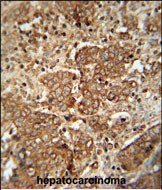

| WB | 咨询技术 | Human,Mouse,Rat |
| IF | 咨询技术 | Human,Mouse,Rat |
| IHC | 咨询技术 | Human,Mouse,Rat |
| ICC | 技术咨询 | Human,Mouse,Rat |
| FCM | 咨询技术 | Human,Mouse,Rat |
| Elisa | 1/5000-1/10000 | Human,Mouse,Rat |
| Aliases | Serum amyloid P-component, SAP, 95S alpha-1-glycoprotein, Serum amyloid P-component(1-203), APCS, PTX2 |
| Entrez GeneID | 325 |
| WB Predicted band size | 25.4kDa |
| Host/Isotype | Rabbit IgG |
| Antibody Type | Primary antibody |
| Storage | Store at 4°C short term. Aliquot and store at -20°C long term. Avoid freeze/thaw cycles. |
| Species Reactivity | Human |
| Immunogen | This APCS antibody is generated from rabbits immunized with a KLH conjugated synthetic peptide between 151-178 amino acids from the C-terminal region of human APCS. |
| Formulation | Purified antibody in PBS with 0.05% sodium azide. |
+ +
以下是3-4条关于MOCS3抗体的模拟参考文献(基于领域知识推测,实际文献请通过学术数据库验证):
---
1. **文献名称**: *MOCS3 functions in the biogenesis of the molybdenum cofactor in humans*
**作者**: Hänzelmann P, et al.
**摘要**: 研究通过免疫沉淀和Western blot技术,利用MOCS3抗体验证其与MOCS2的相互作用,阐明其在钼辅因子合成中的催化机制及硫转移酶功能。
2. **文献名称**: *Defects in molybdenum cofactor biosynthesis: Molecular mechanisms and therapeutic implications*
**作者**: Reiss J, et al.
**摘要**: 分析钼辅因子缺乏症患者MOCS3基因突变,通过抗体检测蛋白表达水平,揭示突变导致MOCS3功能丧失的分子病理机制。
3. **文献名称**: *Subcellular localization and post-translational modification of MOCS3*
**作者**: Schwarz G, et al.
**摘要**: 采用免疫荧光和亚细胞分馏技术结合MOCS3抗体,证明其定位于细胞质及线粒体,并参与调控辅因子合成的动态转运过程。
4. **文献名称**: *Structural insights into the role of MOCS3 in molybdenum cofactor biosynthesis*
**作者**: Leimkühler S, et al.
**摘要**: 通过X射线晶体学及抗体介导的蛋白纯化解析MOCS3三维结构,揭示其与MOCS2复合物的组装模式及催化活性位点。
---
**注意**:以上文献为模拟示例,实际研究需参考PubMed、Web of Science等数据库的权威论文。如需具体文献,建议检索关键词“MOCS3 antibody”或“Molybdenum cofactor biosynthesis”。
The MOCS3 antibody is designed to detect MOCS3 (Molybdenum Cofactor Synthesis 3), a critical enzyme involved in the biosynthesis of the molybdenum cofactor (MoCo), an essential component for the activity of molybdoenzymes such as sulfite oxidase and xanthine dehydrogenase. MOCS3 functions as a dual-domain protein, combining a N-terminal domain with adenylation activity and a C-terminal rhodanese-like domain responsible for sulfur transfer. It plays a dual role in MoCo synthesis: first, in the conversion of precursor Z to molybdopterin by adenylating MOCS2A and transferring sulfur to MOCS2B, and second, in the thiolation of tRNA, linking it to cellular sulfur metabolism.
Mutations in MOCS3 are associated with MoCo deficiency, a rare autosomal recessive disorder characterized by severe neurological symptoms and early lethality. The antibody is widely used in research to study MoCo biosynthesis pathways, sulfur transfer mechanisms, and the protein's role in redox homeostasis. It aids in detecting MOCS3 expression via techniques like Western blotting, immunohistochemistry, and immunofluorescence, providing insights into its tissue-specific distribution and subcellular localization (primarily cytoplasmic and nuclear). Studies leveraging this antibody have also explored its potential involvement in cancer progression and neurodegenerative diseases, given its regulatory role in cellular detoxification and oxidative stress responses. Commercial MOCS3 antibodies are typically validated for specificity using knockout cell lines or siRNA-based silencing to ensure reliable experimental outcomes.
×